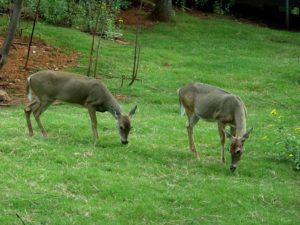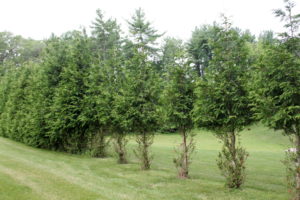Not in My Yard, Deer
February 28th, 2017
Winter is the time when we pay the least attention to our landscape plants, but for deer, it’s prime time.
This is slim-pickings season for the deer food supply, a time when deer look around and realize that the best selection is that line of arborvitae along your property line or those azaleas around the patio.
Much of this stuff is actually pretty tender and tasty, although it still flummoxes me that any animal can eat stems with thorns (roses) or leaves with piercing spines (hollies).
To a gardener, there is no faster way (short of a tornado) to lose a landscape than when a couple of these four-legged eating machines find the yard.
These voracious vegetarians can eat 7 pounds of plants a day, and they carry the mistaken impression that all of those azaleas and arborvitaes you planted are dessert.
The bad news is that a hungry deer will eat almost any plant rather than starve.
The good news, though, is that deer are fairly picky eaters up to that point. If you lean toward their least-favorite choices, that can limit damage. (Read about an interesting deer taste-test study that Penn State’s Deer Research Center did.)
Researchers and publications have deer-resistant plant lists. Unfortunately, deer don’t read those lists, so your selection brilliance can suddenly flame out in one winter’s night.
Plants that deer usually don’t bother include perennials such as ornamental grasses, daffodil, catmint, Russian sage, salvia, hellebore, barrenwort, fern, iris, coreopsis, lavender and bleeding heart, and evergreen shrubs such as boxwood, butterfly bush, caryopteris, juniper, Russian cypress and most viburnums. In general they don’t like pungent flavors and fuzzy or leathery leaves.
Some of their favorites include hosta, daylily, yew, arborvitae, azalea, rhododendron, tulip and most roses.
One of the best lists I’ve seen of deer favorite and non-favorite plants is one published online by Rutgers University Extension.
Realistically, you don’t need deer-proof plants. You just need less tasty plants than your neighbors. Since deer are creatures of habit, steering them elsewhere for safe meals might work. For a while.
Scare tactics are another option, ranging from subtle efforts like hanging out twirl-in-the-wind pie tins to the major-league shock of noise cannons, set to go off at regular intervals. (The neighbors might not care for that one.)
One of the cleverest scares is a hose sprinkler attached to a motion-activated sensor. When deer come into the sensor field, the sprinkler activates – sending the surprised deer into puzzled retreat. (Note: The sprinkler will go off when you walk into the field, too.)
Scent is another shoo-the-deer option. Some gardeners swear by hanging aromatic soap from trees. Irish Spring is the brand of choice. Others use cubes of floral foam soaked in a “soup” of blood meal, ammonia and water, and still others opt for sweaty old shirts or muslin bags of human hair to make deer think an angry human is lurking.
Numerous commercial repellents are available that use concoctions of rotten eggs, hot pepper and other bitter, repugnant ingredients. The key is applying them often enough to keep the scent “fresh.” Repellents help most in winter when the natural food menu is slimmest.
If/when all of that fails, try fencing. Spot-fence vulnerable or valuable specimens with cylinders of wire fence (tall and skinny enough that deer can’t jump in) or erect an 8-foot-tall perimeter fence around the whole yard. Electric fences, a pair of parallel shorter fences (apparently confusing), or posts strung with fishing line (“What invisible threat did I just bump into?”) are other options.
Fenced fortresses should solve your problem once and for all… at least until deer learn to pole-vault.









